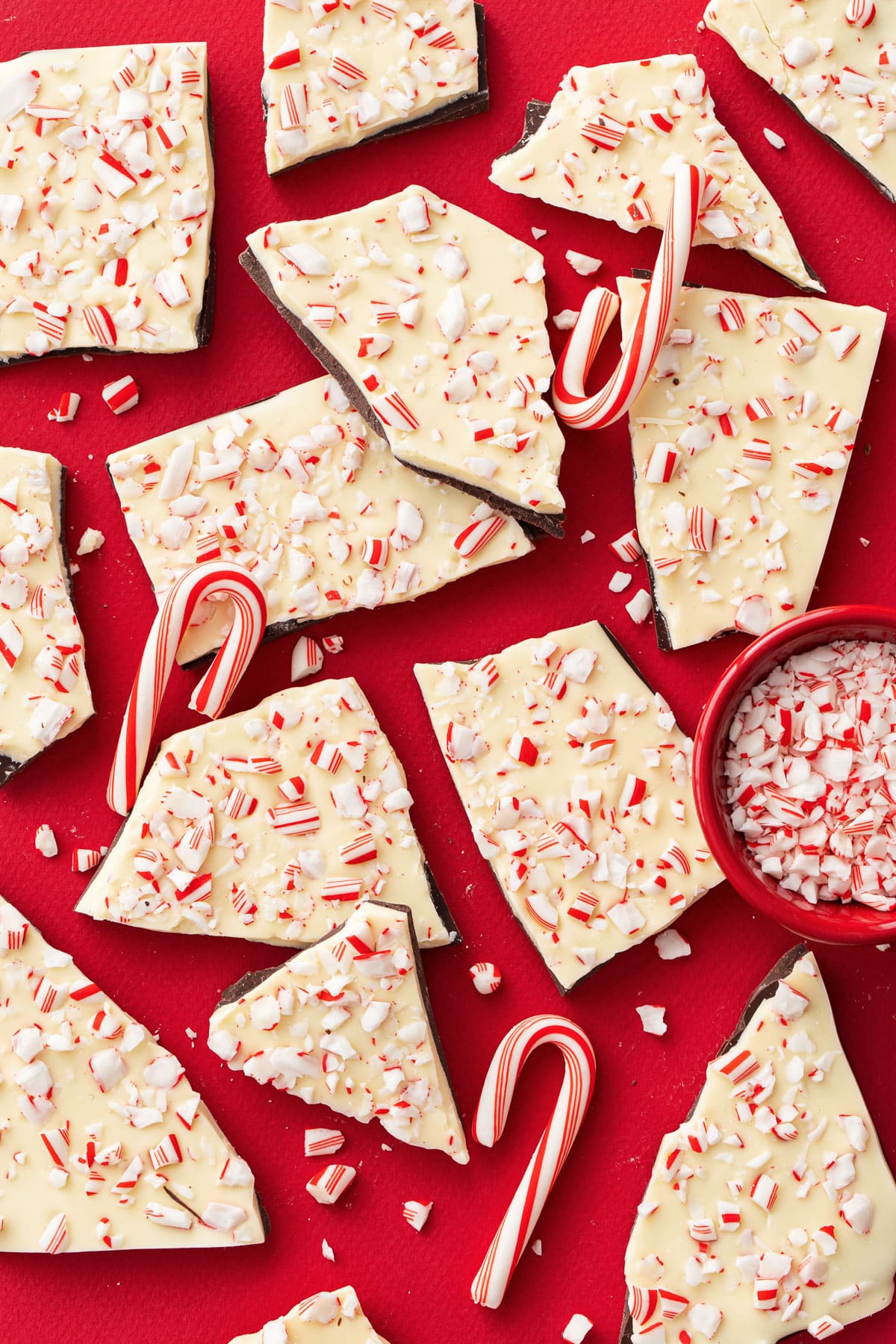Brooks Addington of Tost Beverages talks with SFA News Live's Phil Lempert on-site at the Summer Fancy Food Show.
from Food Trends https://ift.tt/2tTNlUa
Brooks Addington of Tost Beverages talks with SFA News Live's Phil Lempert on-site at the Summer Fancy Food Show.
SFA News Live's host Phil Lempert interviews Glen Miller of Vera Roasting Company at the Summer Fancy Food Show.
SFA News Live's Phil Lempert sits down with Alvin Severien of Algama Food.
SFA News Live's Phil Lempert interviews Gary Hirshberg at the Summer Fancy Food Show in New York.
Several flavor and ingredient trends and product innovations are on the radar as the 2018 Summer Fancy Food Show gets underway. Throughout the show, which runs until Monday, July 2, the SFA Trendspotter panel of buyers, food writers, educators, and other industry professionals, will report daily on their official selections for trends of the Summer Show.
Here are some initial trends and innovations expected to emerge, with a few examples of each. More examples can be found throughout the exhibit halls.
Sparkling and Functional Beverages
According to newly released SFA research, The State of the Specialty Food Industry 2018, produced in collaboration with Mintel, beverage categories collectively have grown 18 percent in retail sales between 2015 and 2017—faster than food categories as a whole. Sparkling and functional beverages, in particular, are prevalent at the show.
Sparkling beverages have been gaining as alternatives to sodas, mixers for cocktails, as well as cocktail alternatives altogether. Some on exhibit include a 2018 sofi New Product winner, Tost dry sparkling white tea with cranberry and ginger, marketed as a sparkling wine alternative. Other examples include Blue Monkey sparkling watermelon juice, Kimino Drinks Yuzu Sparkling, made of yuzu juice, sparkling water, and cane sugar; and O.Vine, a wine-grape infused mineral water from Golan Heights, made with grape skin byproducts from the winemaking process.
Refrigerated RTD functional beverages are up 20 percent, according to the State of the Specialty Food Industry research. While driven in large part by kombucha, more categories are emerging. Exhibitors are offering functional vinegars such as Vermont Village Organic Beauty Boost Functional Vinegar, a combination of raw and organic apple cider vinegar mixed with cherry juice and lime juice and spiked with collagen to replace diminishing levels as consumers age. Other functional beverages include probiotic teas and waters, including Suja Life Probiotic Waters that contain crushed fruit and high probiotic unit count.
Cauliflower
In the quest for the “next kale” cauliflower has appeared with increasing frequency on restaurant menus. Now, more cauliflower-based packaged products are hitting retail shelves, often cheered as a carb substitute as well as a beneficial source of vitamin C, folate, potassium, and magnesium among other nutrients. In addition to riced cauliflower, mashed cauliflower, and cauliflower pizza crust, more products at the show include cauliflower pretzels from Halen Brands’ The Ground Up brand; Caulipower vegetable-based baking mixes; and Hummus Gourmet cauliflower hummus spread made with pureed cauliflower florets.
Foods from the Philippines
The SFA Trendspotter panel noted that Filipino cuisine is one of the top 10 trends for 2018, mostly because of the rise in Filipino restaurants and more chefs putting traditional dishes, or elements of dishes, on their menus. Now, the trend is phasing into retail products that use authentic ingredients and flavors. Examples include calamansi juice, made from a small round citrus fruit that’s similar to a lemon and ubiquitous in the Philippines. Made by a company called Mansi, this juice is high in vitamin C, antioxidants, and electrolytes. Bergenfield, N.J. restaurant CJC Pit Barbecue will also be exhibiting with its bottled lechon sauce, a traditional sauce made from pork liver, vinegar, breadcrumbs, and spices.
Tea Infusions
Tea varieties are being used as ingredients in snacks, treats, and even condiments and sauces. Runamok Maple Jasmine Tea is showcasing a maple syrup infused with jasmine tea, TeaSquares offers black tea infused snack bars that provide a caffeine boost, and Charlie & Sam's Tea has a toffee almond that is enrobed in chocolate that’s been triple infused with organic tea.

Cottage cheese makers are looking to bring the product back into favor targeting younger people looking for a protein-rich, natural snack they can eat instead of a meal. Many brands have emerged selling the cheese in smaller, more appealing packages and placing it closer to yogurt at the supermarket. Some producers are even experimenting with Millennial-friendly additions like probiotics and chia seeds or more exotic flavors like Kalamata olive, habanero chile, and cumin.
Cottage cheese has also been getting more recognition in cheesemaking circles. At the World Cheese Awards in 2017, cottage cheeses from Spain and Luxembourg took silver awards, and two others from Spain and Austria won bronze awards.
However, some say there are a lot of consumers that will get never on board with cottage cheese. Ed Townley, the chief executive officer of Cabot, said the product may see more success if it was different in texture or if it had a different, more appealing name, reports The New York Times. Full Story
Related: Majority of Americans Can’t Identify Cottage Cheese Origins; Wisconsin Names Westby Cottage Cheese Capital.
With a crunchy peanut butter filling and creamy chocolate ganache nestled in a sweet and salty chocolate cookie crust, it’s like a giant peanut butter cup, but bigger and so much better.
Sweet and salty, creamy and crunchy, rich and nutty… this tart has a little bit of everything. While it looks downright impressive with its perfectly defined layers, it takes less than 45 minutes of active time to prepare, although you do need to allow for sufficient chill time between layers and before serving (so plan ahead!)
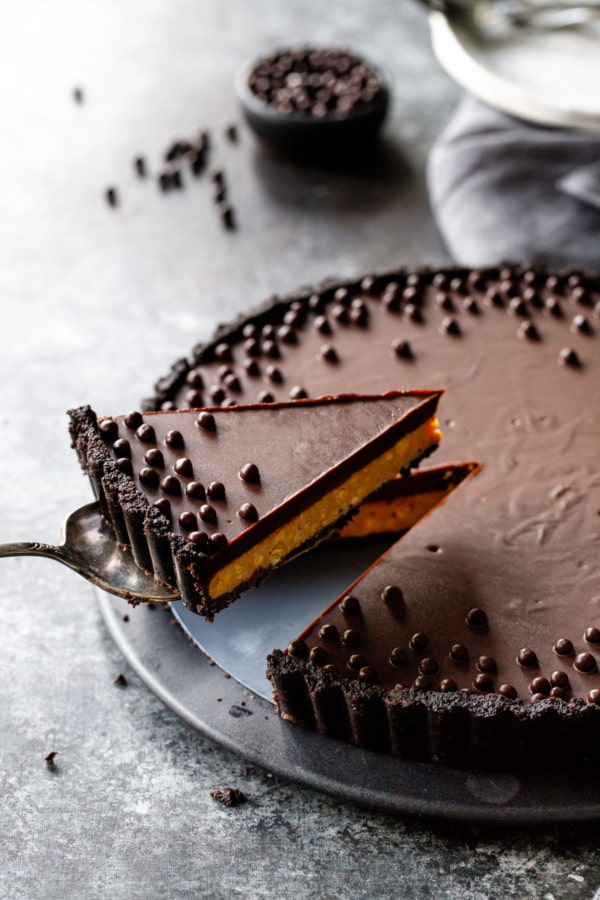
Things have certainly changed since I started blogging.
Back in 2012 or so, it wasn’t uncommon for me to whip something up on the weekend, snap a few photos and have it posted by that very evening.
I don’t know if my standards have changed or what, but now if something turns out perfectly the first time it’s practically a miracle. It’s not unusual for me to have to make something at least 2 or 3 times before it’s deemed post-worthy.
Of course, the difference could be the fact that back then I wasn’t doing many original recipes. It’s much easier to have a first-time success when a recipe is already tried and true; when you are trying and truing it yourself it takes a wee bit more time and effort.
I had high hopes for my first attempt at this tart, which is essentially a giant peanut butter cup with a cookie crust and a delightfully crunchy filling. I made a filling along the lines of a peanut butter buttercream, with a bit of ground toffee for texture and flavor.
It seemed like it was off to a good start, so much so that I started gathering props and setting up the scene with the intention to shoot it that very day.
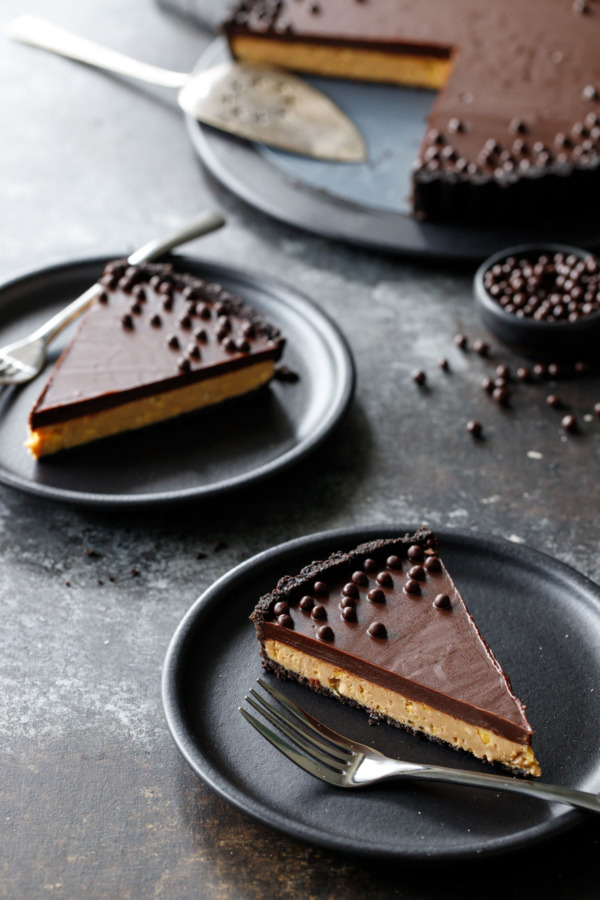
In my attempt to preserve the shiny ganache topping, I didn’t fully chill the tart as I should have. As I sliced into it, the pointy tips of the slices started to droop, and the soft filling started to bulge out the sides under the weight of the ganache on top.
It wasn’t pretty in the least.
I should really know better than to try to shoot my first attempt at any recipe: it’s just a waste of my time.
In this case, it wasn’t just aesthetic reasons that necessitated a do-over. The filling was also far too sweet, and other than adding more powdered sugar, I couldn’t think of a way to make the filling firmer while reducing the sweetness.
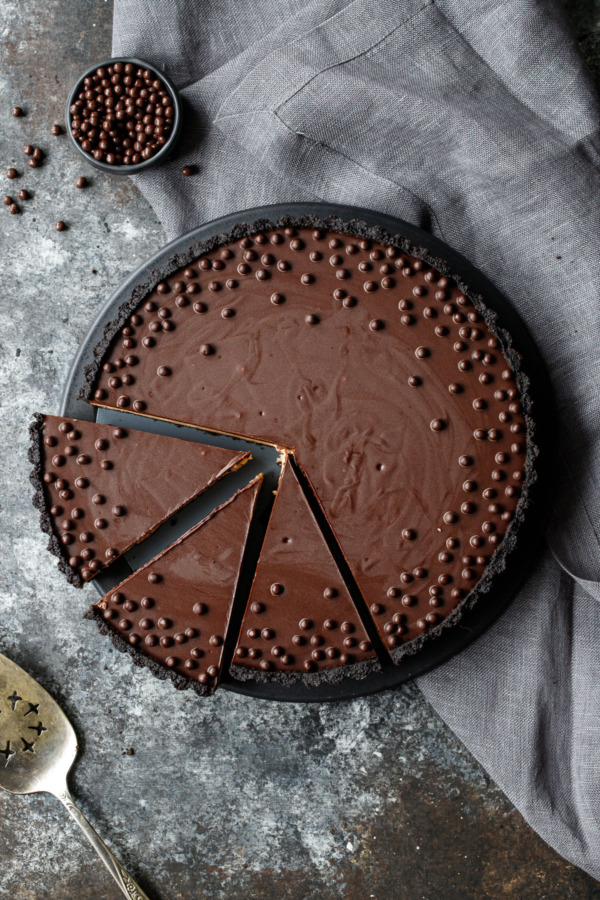
The second time around, not wanting to waste more time and ingredients, I scaled down the filling, trying a few different variations in muffin-tin-sized tarts, mainly to check for overall sweetness and consistency.
The winner was actually the one with the fewest ingredients: with little more than peanut butter and white chocolate (shh, don’t tell Taylor!) and ground up peanut brittle for crunch. The filling doesn’t taste like white chocolate at all, but the white chocolate sets up beautifully when chilled and has a milder, less cloying sweetness than the powdered sugar version.
It’s also much easier to prepare than the buttercream version (which required a mixer) or the raw peanut version (which basically had you making fresh peanut butter from scratch).

As a result, alternatives abound with innovations ranging from almond and cashew spreads, to chickpea, pistachio, and even coconut butters. Each has its own distinctive flavor profile and texture, and is incredibly versatile whether spread on toast, used as a dip for fruit, or added to an ethnic dish. These butters often tout clean ingredient labels and pack a nutritious punch. Here are some of the new alternatives on store shelves.
The Amazing Chickpea Creamy Chickpea Butter. Creamy is The Amazing Chickpea’s flagship variety, made with sunflower seeds for a nutty taste. Spreadable on bread, crackers, or pita, it is thick, rich, and smooth with lots of flavor and a variety of nutritious benefits. Creamy Chickpea Butter is high in fiber and iron, and made with six ingredients: chickpeas, olive oil, sunflower seeds, sea salt, palm oil, and pure cane sugar, and is free of peanuts and tree nuts, hydrogenated oil, and dairy. theamazingchickpea.com
Angry Mills Caffeinated Chocolate Chaos Almond Spread. This rich, dark chocolate is a blend of whey protein isolate with specially milled almonds and high-quality ingredients for a delicious almond spread. Use this caffeinated spread as an afternoon snack or pick-me-up any time of day, or even have a tablespoon or two before intense activity or a workout. From protein breakfast bars to chocolate chip pancakes, Angry Mills Caffeinated Chocolate Chaos Almond Spread can be used in a variety of recipes. Also available in a non-caffeinated variety. sinisterlabs.com
Argania Butter Argan Almond Butter with Honey. This almond butter is made with fresh roasted almonds to bring out the intense nut flavors, sea salt, honey powder, and organic Argan oil, to produce an almond butter that is a good source of protein and vitamin E. Made in small batches without preservatives or artificial flavors, Argania Argan Almond Butter with Honey is packed with omega 3, omega 6 fatty acids, and is high in antioxidants and vitamins A and E. It is gluten-free, non-GMO, and free of trans fat. arganiabutter.com
Binnie’s Simply Cinnamon Coconut Butter. Made with five simple ingredients: organic shredded coconut, organic extra virgin coconut oil, organic agave nectar, organic cinnamon, and sea salt, Binnie’s Simply Cinnamon Coconut Butter can be paired with toast, apple slices, sweet potatoes, crackers, even melted in a pan and poured over a pork chop to shake up dinner. Easily spreadable, Binnie’s Simply Cinnamon Coconut Butter is non-GMO, vegan, organic, gluten-free, and Paleo-friendly. binniescoconutbutter.com
Don’t Go Nuts Chocolate Roasted Soybean Spread. Made with roasted soybeans, Don’t Go Nuts Chocolate Roasted Soybean Spread is a peanut butter substitute that is also gluten-free, certified organic, non-GMO, vegan, and safe for nut-free kids and classrooms. With two times more protein and two-thirds less sugar than chocolate-flavored hazelnut spreads, it is made in a dedicated nut-free facility. Other nut-free flavors from Don’t Go Nuts include Slightly Sweet, Soy Butter, Cinnamon, and Sea Salted. dontgonuts.com
Georgia Grinders Creamy Cashew Butter. Made with two simple ingredients, cashews and sea salt, Georgia Grinders Cashew Butter uses natural, and non-GMO ingredients, resulting in a cashew butter that is silky, smooth, and rich in flavor. Handcrafted in small batches to ensure quality, freshness, and flavor, and made with zero added sugars or oils, this creamy cashew butter adds depth and flavor to any recipe, and is Whole30 approved. georgiagrinders.com
NutRaw Pistachio Butter. What started as a partnership in a small pistachio farm in Central Valley California, soon developed into a mission to create naturally healthy foods without compromising taste, nutrition, and quality. NutRaw Pistachio Butter is 100 percent plant-based, gluten-free, non-GMO, and organic. Made with just organic pistachios and organic vanilla, NutRaw Pistachio Butter is 100 percent raw, without any additives or preservatives. nutrawfoods.com
Nuts ’n More High Protein + Cocoa Hazelnut Spread. Nuts ‘n More High Protein + Cocoa Hazelnut Spread is sweet and healthy. It is gluten-free, non-GMO, high in protein, and made with all-natural ingredients. While most natural butters can be chunky and hard, this cocoa hazelnut spread was created in an innovative way to provide double the amount of protein with a smooth consistency and texture. Additional high protein spreads include Flax Almond Butter, Peanut Birthday Cake Spread, Peanut Chocolate Almond Butter, Chocolate Maple Pretzel, Chocolate Peanut, and Almond Cinnamon Raisin. nuts-n-more.com
Tarazi Tahini. This savory pate is made with 100 percent sesame seeds. No additives, no chemicals, no preservatives, and no salt are added, and it is kosher-certified. Tarazi Tahini is non-GMO, gluten-free, dairy-free, and vegan. It is also a good source of calcium, high in vitamin E, B2, B1, B15, B3, and B5, and high in unsaturated fat. It is easy to digest and higher in protein than most nuts. tarazifoods.com
Wild Friends Foods Almond Cashew Super Butter. This cashew butter is a blend of almonds and cashews with organic clover honey, chia, and flax for an added boost of omega 3s, protein, and fiber. It is creamy, sweet and salty, and great on toast or added to oatmeal bowls, cookies, or smoothies. Wild Friends has partnered with Glory Bee to support its Save the Bee Initiative, and a portion of sales from each jar will go to supporting organizations dedicated to saving the honey bee. wildfriendsfoods.com
Yumbutter Plant Protein + Probiotic Almond Butter. This sprouted, organic, plant-based protein with allergen-free GanedenBC Probiotics is reportedly the first of its kind in the nut butter world. With creamy almond butter and sprouted rice protein, it has 10 grams of protein per two tablespoons. The scientifically formulated protein almond butter supports digestion and increases protein utilization in the body. Yumbutter feeds a child in need through its buy one/feed one holistic business model. yumbutter.com
Sara Kay is content and education specialist for the Specialty Food Association.
Golden brown chicken thighs in a sweet and sticky honey sriracha sauce; serve with a side of jasmine rice and top with fresh cilantro, green onion and toasted sesame seeds.
You can never have too many chicken thigh recipes. It’s one of the most flavorful cuts of chicken, and economical to boot. Here we’ve pan-seared it to a golden brown with a honey sriracha sauce that’s sweet and savory and salty and spicy, all at the same time. This might just be our favorite chicken thigh recipe yet!
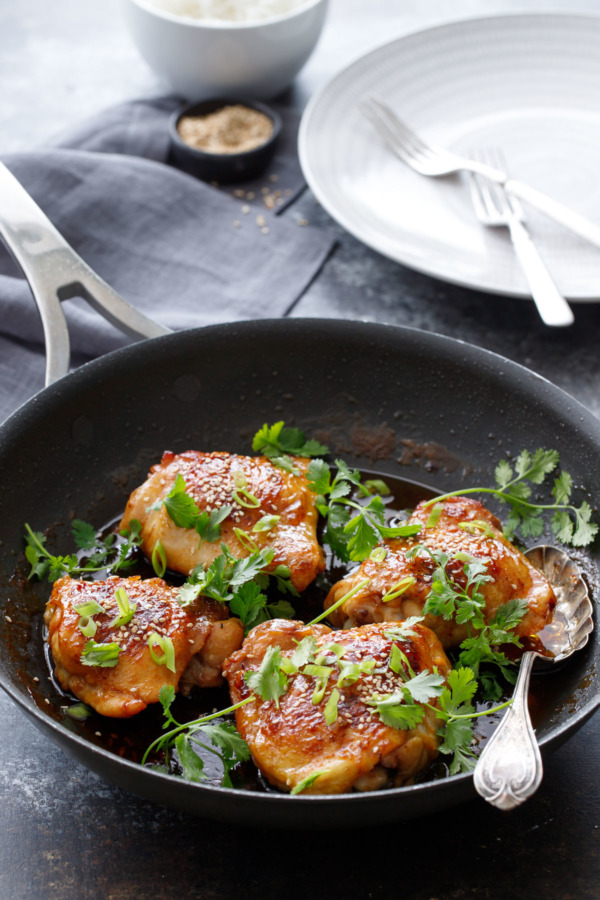
For whatever reason we’ve always had the hardest time browning chicken. Hot pan, cold pan, low heat or high… our chicken never seems to look as pretty as the pictures. (darn food stylists probably rub the things with motor oil or some shenanigans like that, ha!)
But as we were working on this recipe we unintentionally stumbled upon a fool-proof trick for golden brown pan-fried chicken.
Rub it down with sriracha first.
I assume this works so well because the little bit of sugar in the sriracha sauce helps caramelize the surface of the chicken. But that’s just my working theory, I’m no food scientist.
Short story is, it works. And it’s delicious to boot.
Topped with a handful of fresh cilantro and served with a side of jasmine rice, this chicken becomes the perfect weeknight dinner.
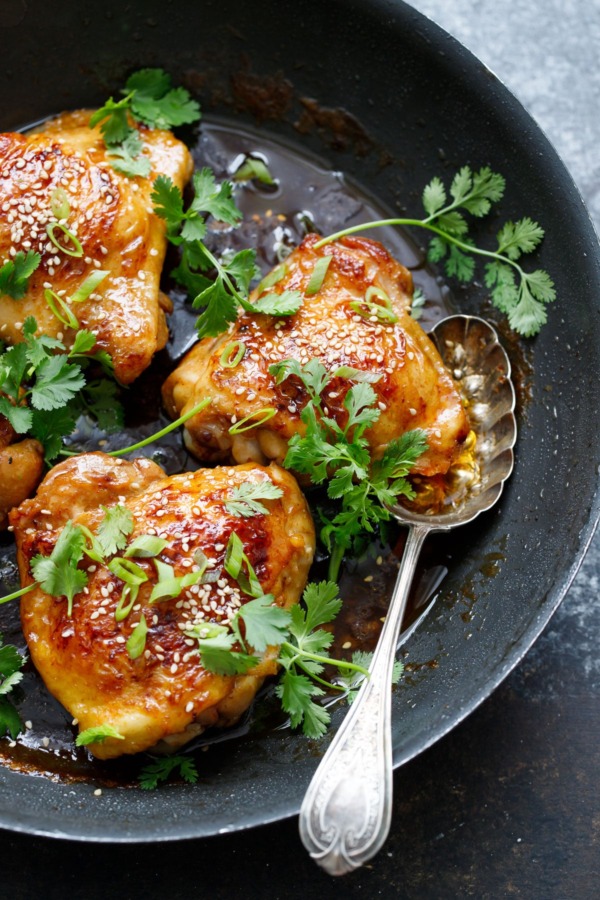
The sauce is the result of Taylor’s brilliance: a little bit of honey and sriracha (but not enough that this dish is what I’d consider to be spicy – feel free to up it if you want to feel the heat) plus garlic, ginger, sesame oil and soy sauce. It’s lightly sweet and super flavorful.
We’ve been tempted to cook everything in it lately, from vegetables to tofu, it’s really that good!

The pipeline is full of young consumers who are enthusiastic buyers of specialty foods, says David Lockwood, director of Mintel Consulting.
For the first time this year, the annual, category-by-category analysis of the specialty food industry from Mintel and the Specialty Food Association includes data on the generation dubbed “iGen,” or people born between 1995 and 2007. The results indicate these young shoppers are consuming specialty foods at a higher rate than older consumers.
“We expect that to continue,” says Lockwood, who is scheduled to present an overview of the research on June 30 at the Summer Fancy Food Show in New York. “It’s an adventurous category, and young people tend to be adventurous and try new things.”
Lockwood recently spoke with Specialty Food News about the research, which he will discuss at the show with Denise Purcell, director of content for the Specialty Food Association.
What are some key trends you've seen in the past year in your analysis of specialty food data?
The main trend is that specialty foods continue to be the growth driver across the entire food retailing market. Conventional food grew at just 1 percent, and specialty food grew at 5.5 percent. The growth rates were a little less than we had forecast, but specialty foods actually gained share at a slightly faster rate than we had forecast. Specialty has been leading the overall food market for a long time, and will continue to do so. We see conventional growing 1.5 to 2 percent a year through 2022, and specialty growing about 6 percent annually.
What results from the research surprised you the most?
To be honest, nothing at all. We’ve been doing this research for about 14 years now, and it’s an industry that consumers love, driven by countless entrepreneurs that are continually delivering new and exciting products. The trend in society at large is that consumers continually want better foods, with better stories, with better provenance, and it all boils down to what specialty foods is best at.
Probably the best new thing to talk about is that this is the first year we’ve actually reported on the i-Generation. The oldest ones are now 18-22 years old, so they fall into our “adult” category. There haven’t been enough in the past to put them in the survey and break them out in any real way. The exciting thing is they are already using and buying specialty food at rates greater than the other generations. It doesn’t mean they are buying more and spending more, but the percentage of them that are doing anything with specialty foods is higher than the percentage in any of the other generations.
Where do you see the most opportunity for specialty food retailers in the coming years?
That too is the same as it has been for years, but it’s worth repeating, and it comes directly from our research. The opportunity for the whole retailing community is to convert light specialty food consumers to heavy specialty food consumers. Of people who say they buy any specialty foods, the average is that they buy 7.8 of our 35 categories. Light buyers average about one to five categories, and heavy buyers average about nine categories. What I always consider to be the exciting thing is there are more light buyers than heavy buyers, so just getting people who are already buying specialty foods to buy more of them is the best opportunity out there.
It’s a question of doing more of what you’re already doing as a retailer — trying to get people to become more engaged in something they are already buying — which shouldn’t be impossible. There is always an immediate payoff for the consumer, because either they are finding better tasting food, or they are finding a brand that connects them to a place or connects them to a cause. Those are, to me, the three hallmarks of specialty foods — it’s either better tasting, or it connects you to a place, or it connects you to a cause.
How do you see the growth of online channels impacting the industry?
Certainly the tail is wagging the dog in a dramatic way. Looking at the broadest definition of specialty — not only specialty foods, but other specialty companies — they have simply used online channels to turn the whole industry upside down. Companies like Birchbox, Chewy.com, Blue Buffalo, private labels that are online, Thrive Markets and Brandless, they have all been either small or previously unknown brands or services that have become really important players, seemingly overnight.
The ramifications aren’t so much about changing market share — it’s also changing how people learn about food, having food delivered to you, and helping people bypass the big CPG company way of doing business. The online channel is really only a couple of billion dollars, less than 2 percent of the total, but obviously it’s growing faster, and it’s changing the way people are doing business. It’s giving food entrepreneurs new ways into the market. Years ago, the only way in was Whole Foods Market, but now there are many more ways to do it.
What are some of the other forces impacting the future direction of the industry?
There are many, but just to name a few:
— Mark Hamstra
Creamy, tangy raspberry ice cream pops dipped in luscious raspberry-flavored white chocolate and sprinkled with freeze dried raspberries. The perfect sweet treat for summer!
Part popsicle, part ice cream bar, entirely delicious: these white chocolate rapsberry ice cream pops are bursting with bright fruit flavor. They’d be great naked too, although I think the white chocolate coating makes them all the more impressive.
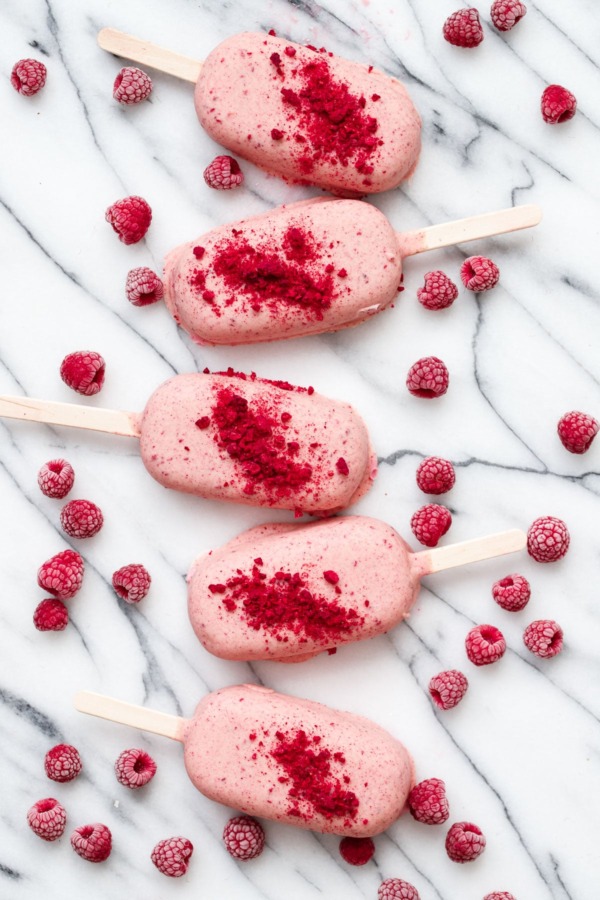
Happy #PopsicleWeek, y’all! Can we just say that I’ll gladly tolerate this ridiculous heat and humidity if it means I can eat popsicles every day.
I set out, on this most wonderful of weeks, to create a creamy fruit popsicle inspired by one of my favorite instagram accounts. I wanted a pop that was bold and fruity and molded into perfectly rounded bars. And bright pink. As pink as a pop can be.
I wanted a creamy consistency, not icy. So the big question is, to churn or not to churn?
I was hoping there’d be a way to get that ice creamy consistency without churning, but alas, even those ‘no churn’ ice cream recipes don’t hold a candle to the real thing. There really is no shortcut or substitute for the controlled freezing of ice crystals (which is what churning does, freezes the ice cream quickly and evenly, creating the smallest ice crystals possible. And smaller ice crystals = creamier ice cream).
The base of these pops is fresh raspberry puree, sugar, cream and buttermilk. The buttermilk is really the secret here, as it perfectly balances the sugar and enhances the tartness of the berries. Liquid yogurt or kefir would likely work as well and achieve the same effect.
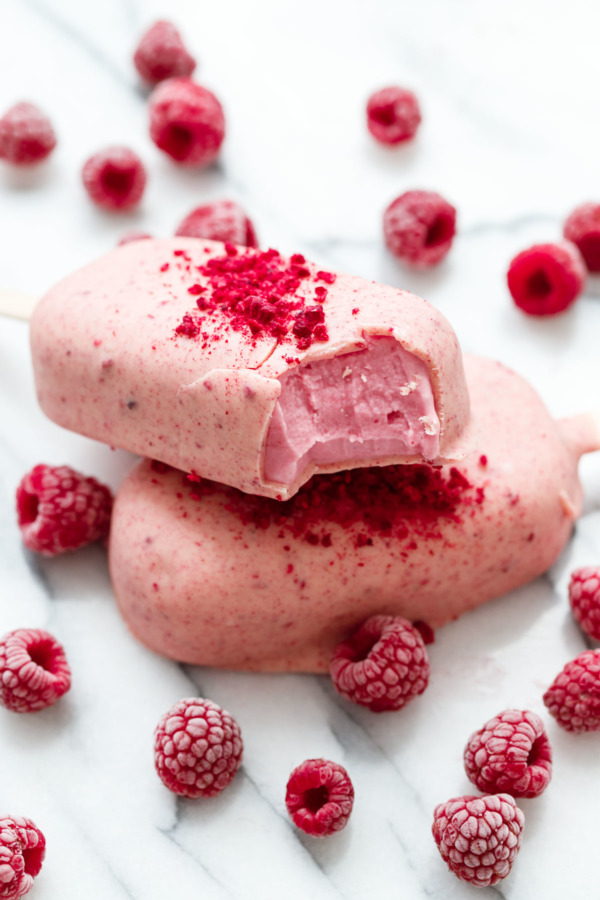
While the raspberry popsicles would be stellar on their own, I dressed them up a bit more by dipping them into raspberry-flavored white chocolate (just white chocolate mixed with crushed up freeze dried raspberries). Granted, I was hoping for a vibrant pepto-pink coating, but the crushed raspberries instead turned the white chocolate a lighter pink with red flecks. I think actual raspberry powder would be finer and would produce a more even shade of pink. Still, they turned out very pretty, even if it wasn’t what I was originally going for.
Now, I know not everyone likes white chocolate. My own husband flat out told me I ruined a perfectly good popsicle by dipping it in the stuff. So know that you can serve these naked and they’re pretty darn awesome.
For me personally though, I love white chocolate and thought it was the perfect compliment to the tart raspberry centers.
While we were in California on our book tour, Alex and I took a few vacation days between our stops in San Francisco and LA to do something very important: drink wine in Sonoma wine country. Our friends from Indianapolis flew in to join us on this very important quest. And it wasn’t just four adults: we had baby Larson in tow! At the time Larson was 14 months old, so we weren’t sure how visiting Sonoma wine country with a baby would go. However, we were pleasantly surprised that wine country is baby friendly. And really, Sonoma is everyone friendly–so if you’re not a parent of a baby or toddler, keep reading too! (We also went to Big Sur, which was incredibly worth a stop.)
Sonoma vs. Napa: which to pick? Eleven years ago, Alex and I visited Napa Valley. We knew nothing about wine, we just knew that Napa meant “fancy wine country.” So we went to Napa: and loved it. This time around, we decided to stay in Sonoma since we heard that Sonoma wine country is less commercial and touristy than Napa has become. If we had more than 2 days, we would have also driven to some Napa wineries. However, we had more than enough things to do in Sonoma to keep us busy for weeks! We loved our stay and would heartily recommend Sonoma wine country.

Our Airbnb could win the ‘Cutest Airbnb on the Pacific Coast’ award. It’s called the Zen House and on some tree-lined land outside of the main strip in Sonoma. The entire aesthetic of the property was incredibly Zen: the architecture and design reminded me of when I was in Japan. Check out this living room! We saw both wild turkeys and deer outside the window on various occasions; it felt very peaceful and serene. (This specific Airbnb was not baby or toddler optimized, so we watched Larson constantly when he was awake. We’d recommend it for adult parties in a heartbeat, or people with very good toddlers.)


By a mile, Scribe Winery was the favorite of any wineries we visited in Sonoma. (Unfortunately Alex missed it since he was with Larson napping!) We did the culinary tasting with the wines, so instead of the tasting room our tasting was at the hacienda, a beautiful old home with an expansive patio area. It was light food not intended to be a meal, but it was incredible: olives, a crisp salad with blue cheese dressing and dill, a whipped feta crostini with brocolli. It was the first winery we visited, so going from a car trip to a sunny patio overlooking a vineyard was pretty ideal. The hacienda was just lovely and we had a view right into the beautiful kitchen. The culinary tasting is a little pricey, but absolutely worth it! Nab a reservation before you go. Here are a few shots from Scribe Winery, in our opinion the best winery in Sonoma.





Of the wineries we visited outside of Scribe (so good, so good!), our favorite other wineries in Sonoma were:



Toting around a 14 month old isn’t necessarily the ideal way to hit up wine country. However, yes: wine country with a baby works! And we had a fantastic time with Larson in tow. We carried him in our LILLEBaby carrier, which is very comfortable to wear (and he loves being in it). With the carrier, he was free to nap when he was tired–which at this age he refuses to do in his stroller. It was also easier than a stroller since it’s not as bulky.
Are babies allowed in Sonoma wineries? Yes. Are babies allowed in Sonoma stand-alone tasting rooms? No. We tried taking Larson to a tasting room in the Sonoma city area and got shut down. So, wineries: yes, tasting rooms: no. Having a toddler around did make things a little more complicated due to nap times. Larson had one 2 to 3 hour nap during the day, so we had him go to the Airbnb with one of us. Since we were travelling with another couple, Alex and me would trade off on being at the Airbnb during nap time and the other person would go out with our friends.
So would we recommend visiting Sonoma wine country with a baby? In our experience, it worked great–though we have a pretty well-behaved baby (or really, toddler). If you have kids that are a bit older, it might be hard to occupy them in wine country. However, we’d love to hear from any of you who have experience visiting wine country with a baby or older children! Let us know inf the comments below.



Honestly, it was hard to find good restaurants in Sonoma! We had a friend who knew the area help us with recs, and we found less than we expected to write home about. Our favorite turned out being a traditional Mexican restaurant called El Molino Central. We got takeout and ate it on our Airbnb patio and it totally hit the spot.
Another thing we loved was getting picnic ingredients and eating at the wineries! Most of the wineries had outdoor areas where you could eat your own food, accompanied by some of their wine. A few times we brought along a bunch of cheeses, crackers, bread, olives, chocolate, and a few premade salads: which really, is the best meal around!
What about you: do you have any Sonoma restaurant recommendations?
A Couple Cooks - Recipes for Healthy & Whole Living
In between our book tour stops in San Francisco and LA, we had a few days of vacation. After two days in Sonoma, Alex, Larson and I decided to head to Big Sur for a day on our way to LA. Honestly, we weren’t quite sure what we were getting into. Most of what we knew about Big Sur was iconic Instagram photos showing insane cliffs and magical sunsets. But when we got there, finding the best sunset view in Big Sur was a bit more difficult than planned. Here’s how to find the best views in Big Sur (and if you’re hardcore, our Big Sur photography guide).

If you don’t live in California, you might be asking the same question. Big Sur is a region of coastline in California known for its massive cliffs and rugged beauty. It’s not a town, or even a state park. But it’s full of gorgeous natural beauty, so when traveling between San Francisco and LA, many travelers opt for the Pacific Coast Highway route instead of the shorter US 101. Without stopping, the 90-mile stretch of Big Sur takes about 2 1/2 hours to drive, which means you can experience it in just one day. For our trip to Big Sur, we had only one day to experience it. Next time, we’d spend more time and stay in the region because it’s just that beautiful.
Here’s the kicker about Big Sur. There aren’t signs that say, “This way to the amazing view”. It’s a long highway with what seems to be hundreds of little pull-offs to take in views of various quality. Also, the views absolutely depend on the weather. When we arrived in Big Sur, it was very cloudy, so it was hard to tell what were the “good” views. However, we persevered and because of it, we got a huge treat at the end (scroll down).
When you drive into Big Sur, you’ll see what seems like an endless stretch of beautiful bright blue water. Even with the cloudy weather early in the day, we were still able to get some good views. We decided to do an initial “drive by” where we drove the entire Big Sur stretch and got out at every opportunity that we were inspired. And, we started scouting for a good spot to come back at golden hour / sunset. That’s when the real magic happens (scroll down).


Fun fact: at the very beginning of Big Sur is the bridge from Big Little Lies, called Bixby Bridge! If you’ve seen the show, you’ll know the opening sequence driving across the bridge set to the song Cold Little Heart by Michael Kiwanuka. Unfortunately we didn’t get any great pics to share here, but it’s another fun Big Sur landmark. Just make sure you download this song before crossing (we forgot to and didn’t have cell service, so we had to sing it to each other!).
At the far south end of Big Sur, you can take a short path out to a cove with a waterfall called McWay Falls. Even with clouds, it’s very beautiful, and it’s totally worth the drive and walk out to it. Part of the trail was closed, so we weren’t able to get as close as we were hoping. Even so, McWay Falls was on our short list of places to come back to at golden hour / sunset. But we had no idea what the sunset view would look like, and whether it would be the classic Big Sur shot that we wanted.

A little after mid-day, the sun started to poke through the clouds and we couldn’t be more excited! Larson had gotten in a little car nap, so we headed to Pfeiffer Beach to poke around. It was incredibly beautiful, as you’ll see from the pics below. We’d absolutely recommend spending time on Pfeiffer Beach! Larson got to dip his toes in the ocean for the first time. At first he was surprised and scared by the cold water, but after giving it a chance he loved it. If you’re wondering how to get to Pfeiffer Beach, it’s a turnoff just north of the Big Sur Bakery, and it’s a 15-minute narrow bumpy drive before you get to the parking lot outside of the beach. (Here’s a map.)



The biggest decision of the day was, Where is the best sunset view at Big Sur? If you’re not familiar, golden hour is that brief time period of the day where the sun is low enough to cast an indirect golden light over everything it touches. It makes for the best photos of landscapes because instead of harsh overhead light and lots of shadows, the entire scene is bathed in a warm glow. We knew golden hour would be the best chance we’d have at a good photo in Big Sur. But since we’d only seen all the vistas under a veil of gray clouds earlier that day, it was difficult to choose. Alex and I spent at least an hour discussing the merits of McWay Falls and the Rocky Creek Bridge viewpoint we’d seen earlier in the day. I knew it was a little silly, but I felt a lot of pressure riding on this decision. We’re in Big Sur for ONE DAY, so we have to choose wisely. What if we blow our only chance at the iconic Big Sur photo?
Alex convinced me that we should go back to Rocky Creek Bridge to take photos, mostly because of logistics. McWay Falls was still a bit cloudy, and if it have a great sunset, we’d be too far away to get back to Rocky Creek Bridge. This decision was a risk, because I’ll show you the Rocky Creek Bridge “before” shot. Here’s what we saw at the Rocky Creek Bridge overlook earlier in the day, covered in clouds.

But at golden hour, around 7:10 pm in late April, it was an entirely different story. The clouds had cleared off for the most part. But from the road, I still wasn’t impressed. Alex, though, had climbed down into the lookout area. Hey, you HAVE to see this, he shouted to me. And when I climbed down and turned north, my eyes teared up involuntarily because it was one of the most beautiful things I’ve ever seen in my life. (Literally. That’s not hyperbole.) It truly looked otherworldly. And it was the most special moment, because what once looked gray and lonely was suddenly golden and breathtakingly beautiful. Here are a few of the Rocky Creek Bridge photos we captured at golden hour. And this, THIS, is why you come to Big Sur.







There’s no town center of Big Sur, and minimal gas stations to refuel. Also, the cell service is spotty. So our best tips are:
As I mentioned above, it was cloudy for much of the time we were in Big Sur. When we shared about the clouds on Instagram, we had a lot of people chime in to agree that it’s often cloudy in the morning and early afternoon in Big Sur. If this happens to you, never fear! Stick it out until sunset, and it’s likely the clouds will burn off.
Big Sur doesn’t have a town center, making it hard to find good eats. However, a local friend turned us on to Big Sur Bakery. It’s open all day, in the morning serving great pastries and the evening serving incredibly high-quality, delicious food. We got a fantastic, beautifully constructed salad and this tasty mushroom pizza with fontina. We requested to sit outside, since we had Larson in tow. He was able to wander a bit and we enjoyed a killer view with killer food. Big Sur Bakery is not to be missed!


So that’s it! All we know about how to find the best views in Big Sur. Have you been, or are you looking to go? In the comments below, please let us know your thoughts and other favorite photo spots!
A Couple Cooks - Recipes for Healthy & Whole Living
A colorful twist on a classic cacio e pepe (cheese and pepper pasta) with homemade arugula spaghetti and toasted pine nuts on top.
The pasta gets its stunning color from fresh baby arugula, blanched and pureed and mixed right into the dough. I mean, there’s an entire bag of arugula in one 4-serving batch, so it’s basically a salad, right?
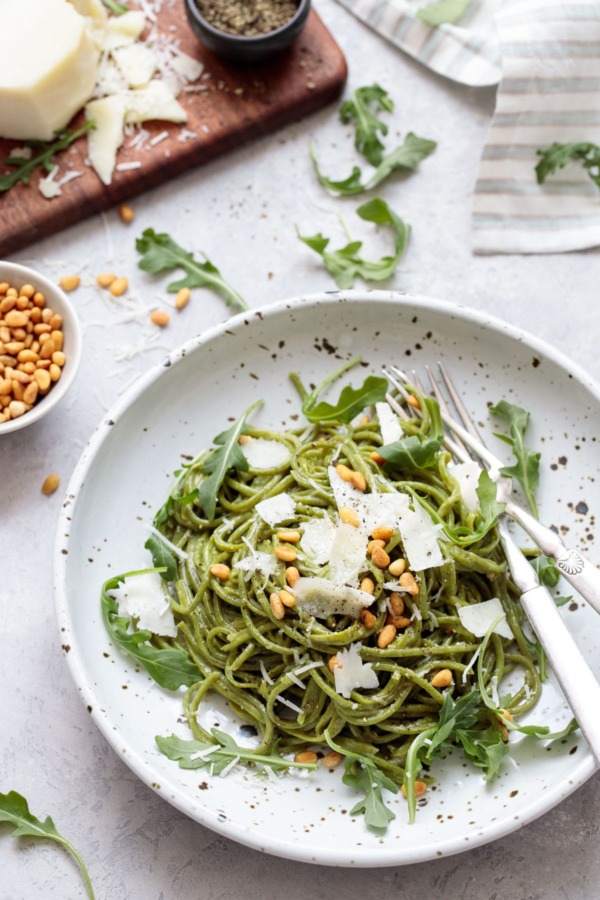
Cacio e pepe is a classic Italian recipe, simply prepared with little more than cheese and pepper. It’s the pasta recipe we turn to when we don’t have anything else to cook (or simply don’t feel like cooking it).
The trick is in the starchy water, which you reserve from the pasta pot and add to the saucepan with the butter, pepper, pasta and cheese. The starch in the water emulsifies with the cheese into a perfectly creamy sauce.
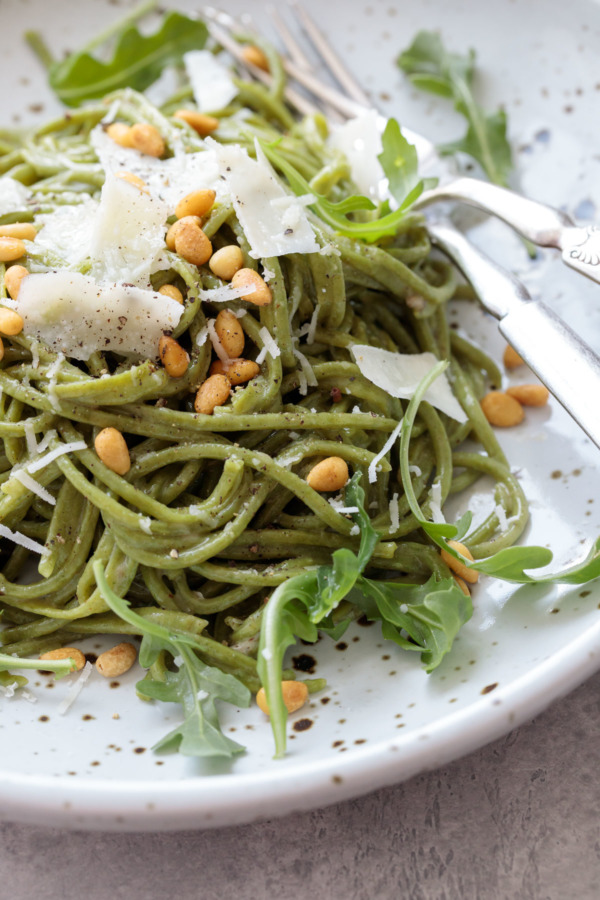
Now, let me just say it doesn’t always work. Sometimes the cheese likes to clump rather than melt (but the result is still plenty tasty). We’ve found that adding the pasta to the saucepan first, then sprinkling the cheese over top, helps it to melt more evenly. Add a splash or two more of pasta water and keep stirring over low heat until the cheese is melted and the sauce appears cloudy throughout.
Another tip? Grate your cheese very finely. Use the fine side of your cheese grater or even a microplane if you have one. This helps the cheese melt quickly and evenly.
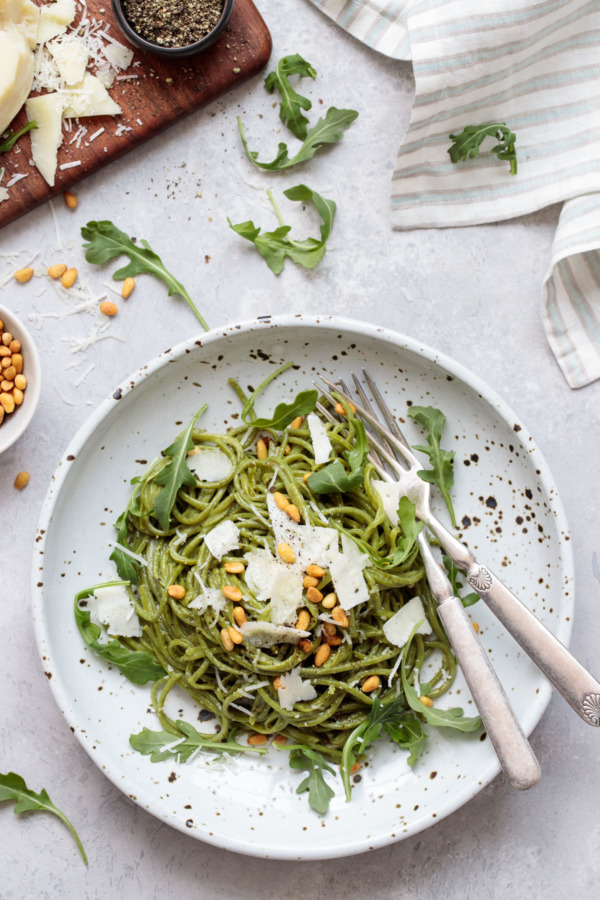
The gorgeous homemade spaghetti noodles are naturally colored with fresh arugula. One 4-serving batch contains an entire bag of fresh baby arugula (how’s that for getting your daily dose of leafy greens?)
The final pasta, however, doesn’t carry the sharp bitter taste of arugula, just the gorgeous verdant color. You can also use fresh baby spinach here too, it’d work just as well.
You’ll go ape wild for this boozy twist on a traditional monkey bread recipe, with bite sized bobbles of homemade brioche dipped in cinnamon sugar and smothered in bourbon banana caramel, then baked until bubbling and crispy around the edges.
Sticky sweet and drunk with flavor, this boozy monkey bread features a banana caramel sauce spiked with a generous dose of bourbon (hence the name) and a scratch-made brioche that’s pillowy soft and oh-so-good. Make the dough the night before and assemble it in the morning of for a perfect brunch for a bunch (one pan easily serves 10 to 12).
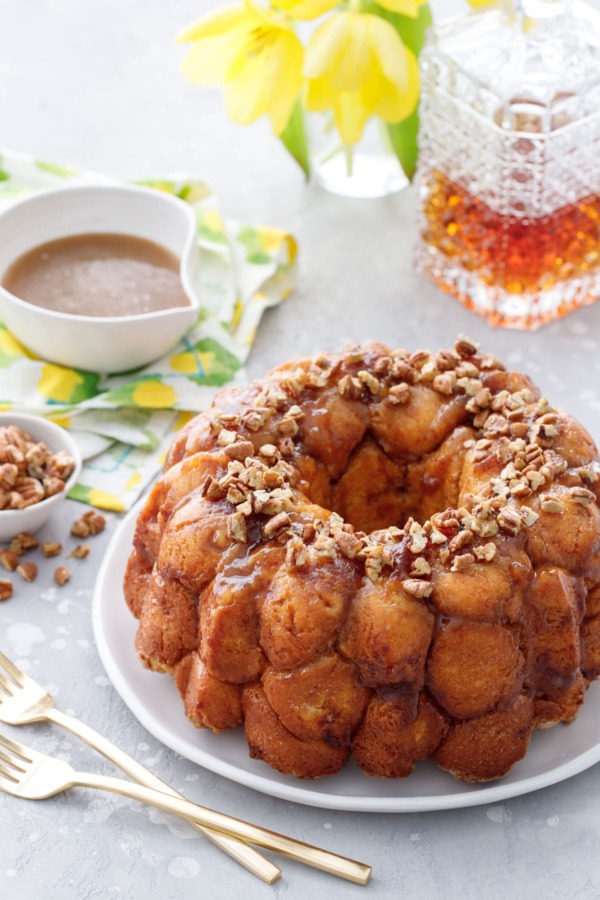
Monkey bread gets its name by the method in which it is eaten: picking off chunks of buttery, gooey dough with your fingers not unlike a monkey grooming his buddy (which is actually a weird thing to name a food after, if you really think about it.)
I figured, it’s called monkey bread, it should have some banana in it. And if monkey bread is good, drunken monkey bread would be even better, so let’s add some bourbon to the mix too (the alcohol pretty much all bakes out in the oven, however it can be replaced by a smaller amount of vanilla if you need something family friendly).
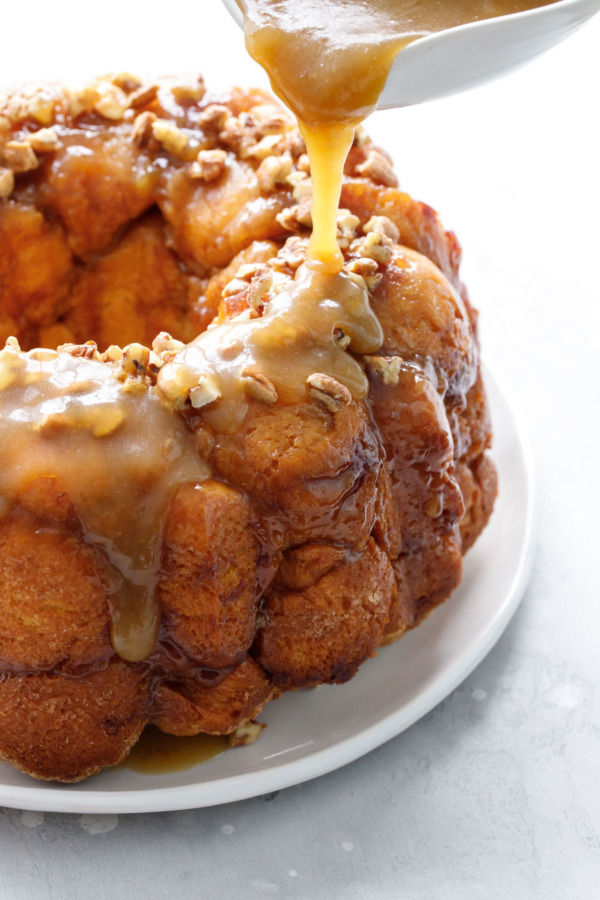
The pièce de résistance is the caramel sauce: sweet and sticky and boozy, like bananas foster in sauce form (and in fact, if drunken monkey bread wasn’t such a fabulous name, I would’ve called it Bananas Foster Monkey Bread).
This caramel sauce is what brings the whole thing together. It’s poured over the raw balls of brioche so they bake up extra sticky and gooey, and also lusciously drizzled on top of the whole thing; there’s even enough leftover for dipping and dunking.
Really, you can’t have too much of this caramel.
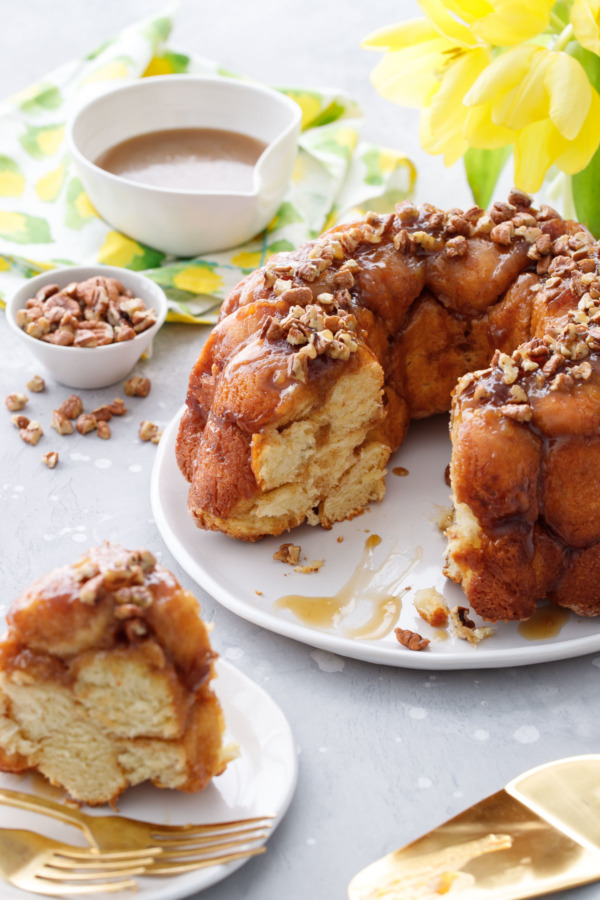
Your favorite chicken parmesan is now an easy-to-make pasta bake! Full of melty mozzarella cheese and a simple, flavorful tomato sauce, this satisfying weeknight dinner recipe might just be a new family favorite!
There’s a reason why chicken parmesan is an Italian-American classic. I mean, you really can’t go wrong with chicken, tomato sauce, and melty cheese. This recipe takes those same bold flavors and adds pasta. It’s like a mix between lasagna, chicken parmesan, and a nice and melty mac ‘n cheese (complete with the bubbly mozzarella and toasted breadcrumbs on top for added crunch).
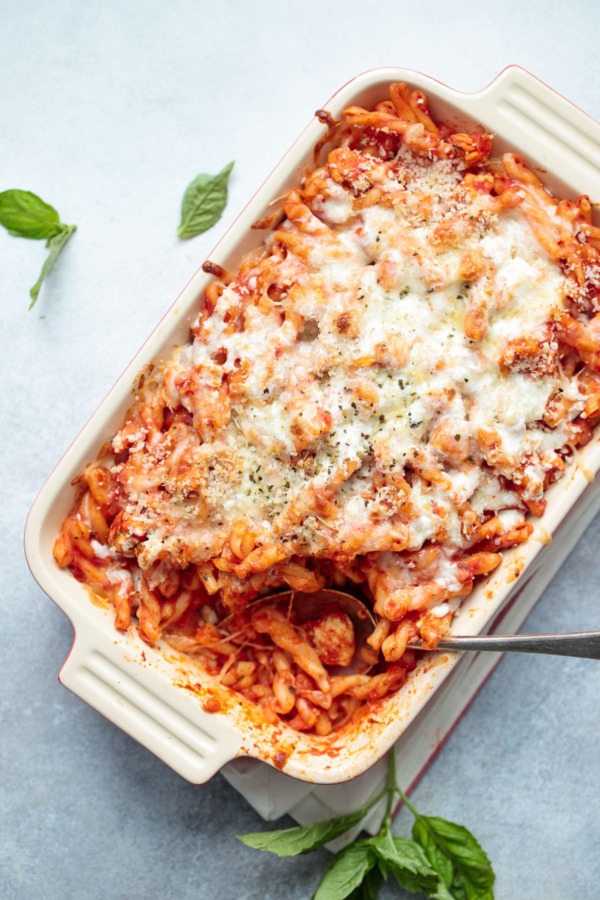
This recipe was created in partnership with Delallo®, our go-to brand for authentic Italian flavor, including pastas, sauces, and specialty imports.
In terms of weeknight dinner recipes, this one checks all the boxes: an easy recipe that yields plenty of leftovers (kill two meals with one recipe? I’m in!) and is ready to eat in under an hour (though only half of that time requires your active attention, so I’d still consider it a quick recipe.)
The whole dish is assembled on the stovetop, the pasta boiled in one pan and the shortcut homemade tomato sauce cooked in the same pan as the chicken, and then layered in a baking dish with plenty of shredded mozzarella and parmesan cheeses. We’ve topped it with a sprinkle of Panko breadcrumbs and a dash of Italian seasoning for good measure.
Taylor loves recipes like this that finish in the oven: it means he’s able to get all the dishes completely done (all of two pots and one spoon needed to make this) before we even sit down to enjoy a hot meal.
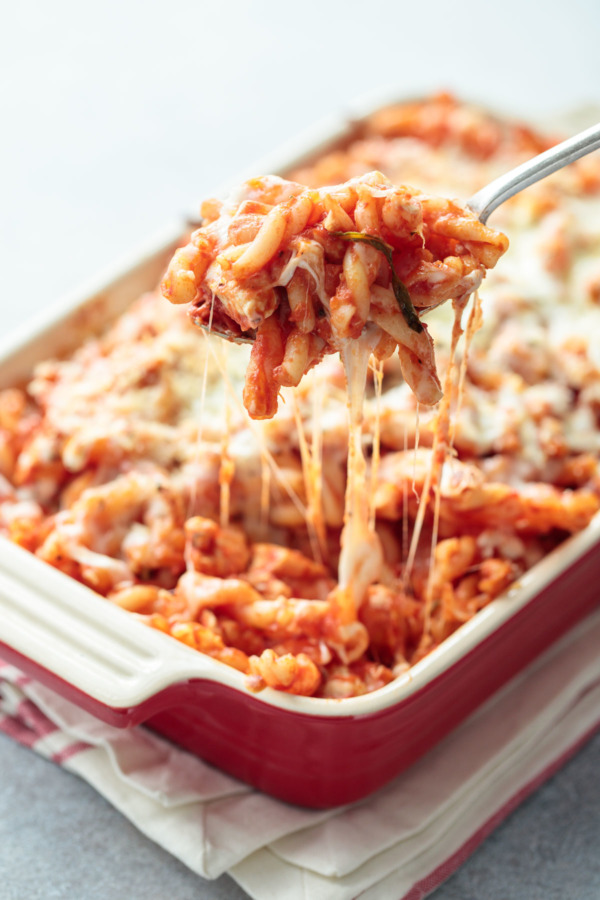
Because the ingredients list is so minimal, it’s important that each ingredient be the best and most flavorful you can find. Take tomato puree, for instance. They are not all created equal. DeLallo’s new Passata Rustica Rich Tomato Purée is thick, velvety and robust, about as close as you can get to a ripe summer tomato in a can (excuse me, jar – and what a gorgeous jar it is!) It’s easily the best canned tomato purée I’ve ever tried.
A tomato purée this good really doesn’t need much to become a luscious tomato sauce: a bit of garlic and onion, fresh basil, and some salt and pepper and that’s about it. Talk about an easy homemade tomato sauce in no time.
Peppermint bark is a satisfyingly simple holiday treat, with two gorgeous layers of dark and white chocolates and a flurry of candy cane pie...
